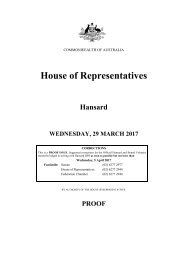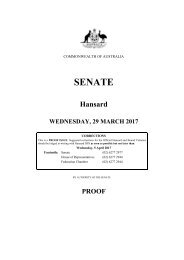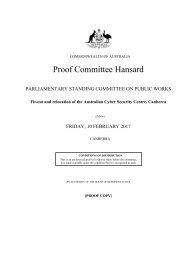SENATE
2mKfSKX
2mKfSKX
You also want an ePaper? Increase the reach of your titles
YUMPU automatically turns print PDFs into web optimized ePapers that Google loves.
Wednesday, 1 March 2017 Senate Page 13<br />
Senator FARRELL: And you are noticing an increase in confidence?<br />
Air Chief Marshal Binskin: There is an increase in confidence. And, as I mentioned in my opening<br />
statement, a battle-hardened approach to what they are doing. We are seeing it in their employment of tactics,<br />
how they manoeuvre and how they coordinate, improving with each iteration as well and with each assault. In the<br />
assault of Mosul we have seen them change their tactics and improve how they coordinate between the CTS, the<br />
federal police, the regular army and how they are manoeuvring. So we are seeing that improvement month to<br />
month as the operations continue.<br />
Senator FARRELL: You would say that was partly because of the training that we are giving them?<br />
Air Chief Marshal Binskin: It is definitely because of the training that not only Australia is giving them but<br />
other members of the coalition as well, and the building partner capacity. Then there is also the work that our<br />
Special Operations Task Group is doing in conjunction with a couple of other nations, working very closely with<br />
counterterrorism service. We are definitely seeing the input of the mentoring, the advising and the assisting there<br />
being played out in operations.<br />
Senator FARRELL: Did you say we have trained 16,000?<br />
Air Chief Marshal Binskin: If you look at the total, it is about 19,000 when you combine everything. I think<br />
the minister mentioned 16,000 Iraqi army and then there are police on top of that.<br />
Senator Payne: There are 2,000 or so police.<br />
Air Chief Marshal Binskin: When you add it all up it is about 19,000.<br />
Senator FARRELL: I think you mentioned in your opening statement about the retaking of east Mosul. Now<br />
activity is focused on west Mosul. Can you give us any clearer picture of what is happening there?<br />
Air Chief Marshal Binskin: I think what you are seeing in the open source media gives you a good idea of<br />
the operations and the intensity of fighting that is going on in west Mosul.<br />
Senator FARRELL: All right. I want to read out a little media report from 22 February and ask a question<br />
about it. It said:<br />
But an estimated 750,000 civilians are under siege across the Tigris River which is home to the old city with narrower<br />
streets and denser terrain.<br />
Australian Defence Force chief of joint operations Vice Admiral David Johnston—<br />
Not to be confused with the Senator—<br />
warned there is likely to be IS (Daesh) sleeper cells among the civilian population in the city's east who will conduct terrorist<br />
attacks to delay the offensive in the west.<br />
Do you have any advice on the number of civilian casualties arising from the ground offensive?<br />
Air Chief Marshal Binskin: I do not have advice on the number of civilian casualties, but I can say to you<br />
that everything that we do in our operations aims to minimise civilian casualties. When they are in a war zone,<br />
and it is a tight urban area, that is difficult to do. But part of our processes and what we work with the Iraqis with<br />
is always to look to minimise civilian casualties in the operations.<br />
That being said, we are working against an adversary, ISIL, who do not care about civilian casualties. In fact,<br />
inflicting as much damage as they can on the population is a part of their operation. It is a tragedy. As we get into<br />
the closer urban fighting in Mosul—and it is tighter, as the old city of Mosul is on the western side–that could<br />
become more of an issue. It is just something that the planners will have to take into account and those on the<br />
ground will have to factor in for their operations.<br />
CHAIR: Can I just ask you to stop there for a moment and I will go to Senate Fawcett.<br />
Senator FAWCETT: Mr Richardson, can I move on from your opening statement to the budget overview? I<br />
would like to talk specifically about table 1.3, budget measures, which I note has not been updated in your<br />
additional estimates. I have raised a number of times in the past the issue of transparency of absorbed measures<br />
and I am pleased to see in this table there are some footnotes that actually highlight some absorbed measures.<br />
Having highlighted those, are they the only absorbed measures in the budget or are there others that have not been<br />
flagged?<br />
Mr Richardson: No, that would not be the totality of absorbed measures.<br />
Senator FAWCETT: Could I commend you for identifying some and request that, where possible, any<br />
individual amount that can be identified as an absorbed measure is? I repeat my request in the light of what we<br />
have seen in the past where a lot of back-of-house functions were hollowed out as a consequence of absorbed<br />
FOREIGN AFFAIRS, DEFENCE AND TRADE LEGISLATION COMMITTEE















